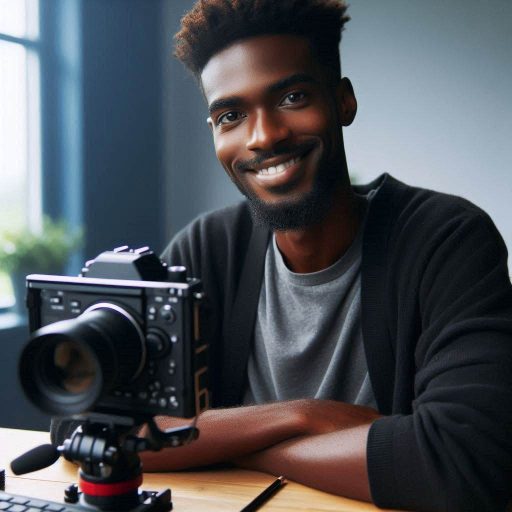Introduction
Multimedia artists create visual effects, animations, and graphics for various mediums. Despite their creativity, they face several challenges.
Working with complex software and hardware can be daunting.
Artists must stay updated with the latest technology to overcome this challenge.
Tight project timelines can cause stress.
Artists need to manage their time efficiently to deliver high-quality work on time.
Creativity can sometimes hit a roadblock.
To stay inspired, artists must explore new techniques, collaborate with peers, and take breaks when needed.
Ongoing feedback is crucial for improvement.
Artists should be open to constructive criticism and use it as a tool for growth.
Clients may request multiple revisions, leading to frustration.
Effective communication and setting clear expectations can help streamline this process.
Long hours spent in front of screens can impact health and well-being.
Artists need to prioritize self-care and relaxation to avoid burnout.
Promoting one’s work and networking with potential clients can be challenging.
Building a strong online presence and attending industry events can help in this regard.
In essence, while multimedia artists face various challenges, they can overcome them by staying updated with technology, managing time effectively, seeking inspiration, embracing feedback, communicating clearly, prioritizing self-care, and actively promoting their work.
Lack of Inspiration
How creative block can hinder multimedia artists
Multimedia artists often face the challenge of encountering a creative block, hindering their ability to produce new and innovative work.
This lack of inspiration can be frustrating and demotivating, making it difficult to stay productive and meet deadlines.
However, there are several strategies that multimedia artists can employ to overcome this common challenge and reignite their creative spark.
Ways to overcome lack of inspiration such as exploring new mediums or taking breaks
One way to combat a lack of inspiration is by exploring new mediums and techniques.
Transform Your Career Today
Unlock a personalized career strategy that drives real results. Get tailored advice and a roadmap designed just for you.
Start NowStepping out of your comfort zone and trying something different can help stimulate your creativity and push you to think outside the box.
For example, if you typically work in digital art, consider experimenting with traditional mediums like painting or sculpting.
This change of pace can help you break free from creative stagnation and discover new ways to express your ideas.
Another effective strategy for overcoming a creative block is to take breaks and give yourself time to recharge.
Sometimes, pushing yourself to create when you’re feeling uninspired can lead to even more frustration and burnout.
Instead, allow yourself to step away from your work and engage in activities that inspire you, whether it’s going for a walk in nature, listening to music, or reading a book.
Taking these mental breaks can help refresh your mind and provide a new perspective when you return to your projects.
Additionally, seeking inspiration from other artists and creative professionals can help spark new ideas and ignite your creativity.
Attend art exhibitions, watch films, read books, or explore online platforms like Behance or Dribbble to discover the work of others and gain fresh insights.
Engaging with different artistic styles and perspectives can inspire you to try new approaches in your own work and overcome creative blocks.
In fact, a lack of inspiration is a common challenge faced by multimedia artists, but it is not insurmountable.
By exploring new mediums, taking breaks, and seeking inspiration from others, artists can overcome creative blocks and tap into their full potential.
Remember, creativity is a journey, and embracing challenges along the way can lead to growth and innovation in your artistic practice.
Read: The Future of Multimedia Art and Design
Tight Deadlines
How multimedia artists often work on projects with strict deadlines
One common challenge that multimedia artists face in their work is tight deadlines.
Working on projects with strict deadlines is a common occurrence for multimedia artists.
Whether it’s creating animations, designing graphics, or editing videos, clients often require quick turnarounds.
Solutions to Manage Time Effectively
- Create a Schedule: One effective way to manage time as a multimedia artist is to create a detailed schedule for each project.
Break down tasks into smaller, manageable chunks and allocate specific blocks of time to work on each task. - Prioritize Tasks: Another key strategy is to prioritize tasks based on their importance and deadlines.
Focus on completing high-priority tasks first before moving on to less urgent ones. - Set Realistic Goals: Setting realistic goals for each project can help you stay on track and avoid feeling overwhelmed.
Be honest with yourself about how much time you need to complete a task and plan accordingly. - Use Time Management Tools: There are plenty of time management tools available that can help you stay organized and focused.
Consider using project management software, time-tracking apps, or digital calendars to keep track of your tasks and deadlines. - Avoid Multitasking: While it may be tempting to work on multiple projects at once, multitasking can actually decrease your productivity.
Focus on one task at a time to ensure that you are giving each project your full attention.
By implementing these strategies and tools, multimedia artists can effectively manage their time and meet tight deadlines without sacrificing the quality of their work.
Read: From Concept to Creation: Multimedia Art Workflow
Technical Issues
One of the common challenges that multimedia artists face is technical issues.
Transform Your Career Today
Unlock a personalized career strategy that drives real results. Get tailored advice and a roadmap designed just for you.
Start NowThese can include software glitches or equipment malfunctions, which can be frustrating and time-consuming to deal with.
Addressing Technical Problems
- Ensure all software and hardware are up-to-date to prevent potential glitches.
- Regularly backup your work to avoid losing important files in case of technical failures.
- Monitor the performance of your computer or device to catch any issues early on.
- Check for any updates or patches for your software to fix known bugs or issues.
- Keep your workspace organized and clutter-free to prevent accidents or damage to equipment.
Tips for Troubleshooting
- Restart your computer or device to see if that resolves the technical issue.
- Check all cables and connections to ensure everything is properly connected.
- Consult online forums or user communities for help and possible solutions.
- Test your equipment on another device to determine if the issue is hardware-related.
- Consider seeking help from tech support or a professional if you cannot resolve the issue on your own.
By following these tips and being prepared for technical issues, multimedia artists can minimize disruptions to their work and stay focused on creating their art.
Read: Industry Tools Every Multimedia Artist Should Know

Client Feedback
How criticism from clients can be challenging for multimedia artists
Receiving criticism from clients can be challenging for multimedia artists because it can sometimes feel personal and discouraging.
Artists put a lot of time, effort, and creativity into their work, so negative feedback can be hard to hear.
Strategies for handling constructive feedback and incorporating suggestions effectively
However, handling constructive feedback is essential for growth and improvement.
Here are some strategies for multimedia artists to effectively handle client feedback:
- Stay Calm: When receiving criticism, try to remain calm and not take it personally.
Remember that the feedback is about the work, not about you as a person. - Listen Carefully: Pay close attention to what the client is saying and try to understand their perspective.
Sometimes, clients might not communicate their feedback clearly, so ask for clarification if needed. - Ask for Specifics: If the feedback is vague or general, ask the client for specific examples or details.
This will help you address their concerns more effectively. - Don’t Be Defensive: It’s natural to feel defensive when receiving criticism, but try to keep an open mind and consider the client’s feedback as an opportunity for improvement.
- Take Time to Process: Instead of reacting immediately, take some time to process the feedback.
Reflect on it and think about how you can use it to enhance your work. - Implement Changes: Once you have processed the feedback, make the necessary changes to your work.
Use the client’s suggestions to improve the quality of your multimedia projects. - Seek Clarification: If you’re unsure about the client’s feedback or need more information, don’t hesitate to ask questions.
Clear communication is key to addressing feedback effectively. - Follow Up: After implementing the changes, follow up with the client to ensure that they are satisfied with the revisions.
This shows that you care about their feedback and are committed to delivering quality work.
Incorporating client feedback is an essential part of the creative process for multimedia artists.
By learning how to handle criticism constructively and implementing suggestions effectively, artists can build stronger relationships with clients and produce better work.
Remember, feedback is not a sign of failure, but an opportunity for growth and improvement.
Read: How to Network in the Costume Design Industry
Balancing Creativity and Commercialism
One of the common challenges that multimedia artists face is the dilemma between balancing creativity and commercialism.
It can be quite challenging to stay true to their artistic vision while also meeting the demands of the commercial world.
Exploring the Dilemma
Multimedia artists often find themselves torn between creating art that is personally fulfilling and art that will sell.
This can create a conflict within the artist, as they may feel pressured to compromise their vision in order to make a profit.
On one hand, artists want to express themselves creatively and create work that is meaningful to them.
On the other hand, they also need to sell their work in order to make a living.
This balancing act can be quite difficult to achieve.
Finding a Balance
- Set clear goals: Define your artistic goals and commercial goals clearly to help guide your work.
- Collaborate: Work with others who can help you navigate the creative and business aspects of your work.
- Market research: Understand your audience and market trends to create work that is both creative and commercially viable.
- Experiment: Don’t be afraid to try new things and push the boundaries of your creativity while keeping an eye on market demand.
- Time management: Allocate time for both creative exploration and business activities to ensure a balance between the two.
- Value your work: Don’t undersell yourself or compromise on quality to meet commercial demands. Stay true to your artistic integrity.
- Seek feedback: Listen to feedback from both artistic peers and potential customers to improve your work without losing your creative vision.
- Stay adaptable: Be open to change and willing to adapt your work to meet both creative and commercial needs as they evolve.
- Network: Build connections within the industry to help you navigate the challenges of balancing creativity and commercialism.
- Continuous learning: Keep learning and growing as an artist to stay ahead of the curve in both creative and business aspects.
By following these strategies, multimedia artists can find a balance between their creative desires and commercial demands.
It is possible to create work that is both artistically satisfying and commercially successful with the right approach and mindset.
Transform Your Career Today
Unlock a personalized career strategy that drives real results. Get tailored advice and a roadmap designed just for you.
Start NowFinding Employment Opportunities
The competitive nature of the multimedia industry and the difficulty in finding job opportunities
The multimedia industry is highly competitive, making it challenging to secure job opportunities.
Many talented individuals vie for the same roles, which intensifies the competition.
To stand out, multimedia artists must take proactive steps.
Tips for networking, building a strong portfolio, and staying updated on industry trends
Networking is crucial for finding job opportunities.
Attending industry events, conferences, and workshops helps build valuable connections.
Engage with professionals on social media platforms, such as LinkedIn and Instagram.
Join industry-related groups and forums to stay visible.
Building a strong portfolio is essential.
Showcase a diverse range of projects that highlight your skills and creativity.
Tailor your portfolio to the type of jobs you want to attract
Regularly update it with your latest work to demonstrate your growth.
Staying updated on industry trends is also important.
Follow industry blogs, subscribe to relevant newsletters, and participate in online courses.
This knowledge keeps your skills relevant and makes you more attractive to potential employers.
By actively networking, maintaining an impressive portfolio, and keeping up with trends, multimedia artists can improve their chances of finding job opportunities.
These strategies help you stand out in a crowded field and connect with the right people.
Find Out More: Top Curatorial Practices for Engaging Exhibits
Self-Doubt and Imposter Syndrome
How self-doubt and imposter syndrome can affect multimedia artists’ confidence
Self-doubt and imposter syndrome often plague multimedia artists, impacting their confidence and creativity.
These feelings can undermine an artist‘s belief in their abilities and hinder their professional growth.
Self-doubt frequently arises when artists compare their work to others.
Transform Your Career Today
Unlock a personalized career strategy that drives real results. Get tailored advice and a roadmap designed just for you.
Start NowThey might question their skills or worry about their place in the industry.
This constant self-criticism can erode confidence and stifle creativity.
Imposter syndrome, on the other hand, involves a persistent fear of being exposed as a fraud.
Artists with this syndrome may feel like they don‘t deserve their achievements or that they are not as competent as others believe them to be.
This mindset can lead to chronic stress and anxiety.
Techniques to boost self-esteem and overcome feelings of inadequacy
To combat self-doubt, artists should focus on their strengths and past successes.
Keeping a journal of accomplishments and positive feedback can help reinforce their self-worth.
Setting realistic goals and celebrating small victories also boosts confidence.
Overcoming imposter syndrome involves acknowledging and challenging these negative thoughts.
Artists can remind themselves of their qualifications, skills, and past achievements.
Engaging in self-reflection and seeking feedback from peers can provide valuable perspective and validation.
Another effective technique is to adopt a growth mindset.
Embracing challenges as opportunities for learning rather than threats to their competence can reduce feelings of inadequacy.
Artists should also consider seeking mentorship or joining professional groups to gain support and reassurance from others in the field.
By addressing self-doubt and imposter syndrome head-on, multimedia artists can enhance their self-esteem and foster a more positive and productive creative environment.
Conclusion
Multimedia artists often face challenges such as technical issues, creative blocks, tight deadlines, and competition.
It is crucial for multimedia artists to persevere through these challenges to succeed in the industry.
Being resilient in the face of setbacks allows multimedia artists to bounce back stronger and more determined.
It is essential for multimedia artists to seek support from peers, mentors, and online communities to navigate challenges effectively.
By staying determined, resilient, and seeking support, multimedia artists can overcome common challenges and achieve success in their careers.
Transform Your Career Today
Unlock a personalized career strategy that drives real results. Get tailored advice and a roadmap designed just for you.
Start Now



